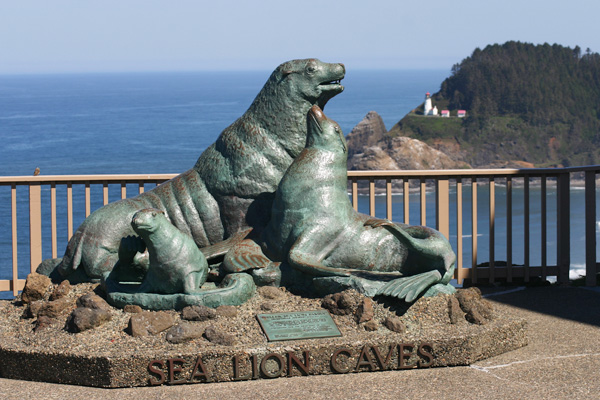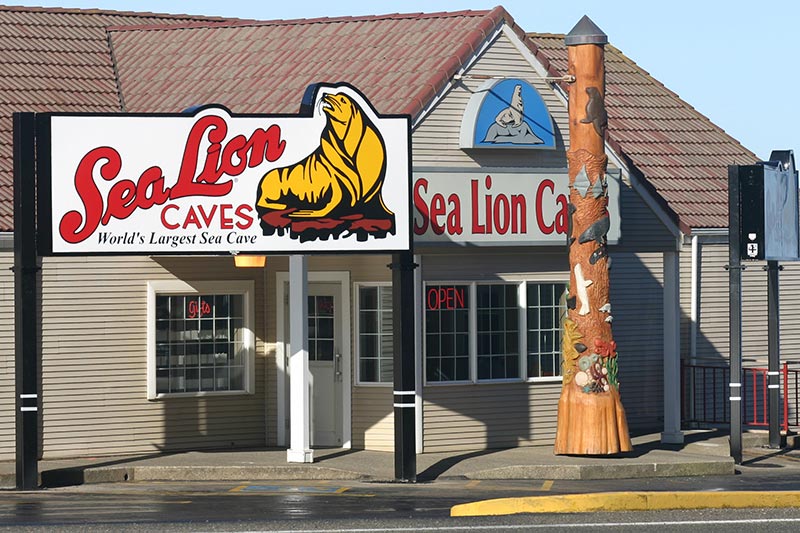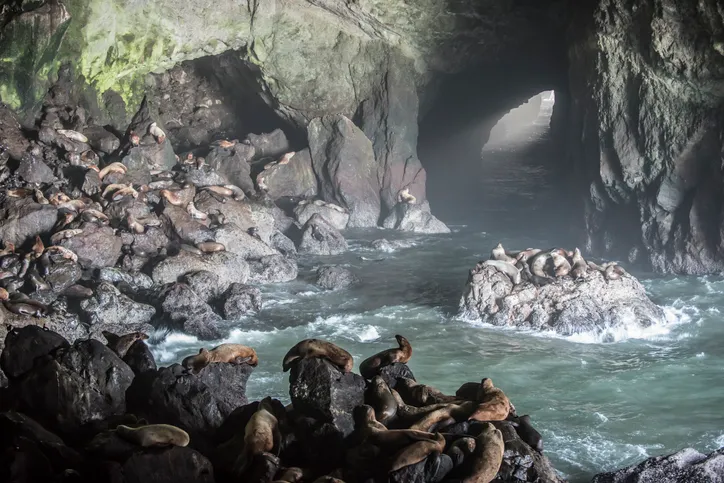Overview
Sea Lion Caves Florence is a stunning natural wonder on the Oregon Coast, famous for being America’s largest sea cave and a haven for Steller sea lions. Located 11 miles north of Florence, Oregon, it’s a must-visit for anyone exploring the area.
Key Features
Research suggests the cave, formed over 25 million years ago, spans about 2 acres with a ceiling soaring 125 feet high, accessible via an elevator that descends 208 feet. It’s a wildlife preserve, home to Steller sea lions year-round, though their numbers may vary by season, and also hosts sea birds like gulls and cormorants.
Key Points
-
Research suggests Sea Lion Caves Florence is a major natural attraction, known as America’s largest sea cave, located 11 miles north of Florence, Oregon, on the Oregon Coast.
-
It seems likely that the caves, formed over 25 million years ago, are a year-round home for Steller sea lions, with varying numbers depending on the season.
-
The evidence leans toward the caves being a privately owned wildlife preserve since 1932, offering elevator access for visitors to observe marine life in their natural habitat.
-
Nearby attractions like Heceta Head Lighthouse and the Oregon Dunes National Recreation Area enhance the coastal adventure experience.
Visitor Experience
It seems likely that visitors can enjoy observing marine life in their natural habitat, with admission fees around $15–$20 (check Sea Lion Caves for current pricing). The site is open year-round, except on specific holidays, and offers pathways and viewing areas for a close-up experience.
Nearby Attractions
The evidence leans toward nearby spots like Heceta Head Lighthouse and the Oregon Dunes National Recreation Area [https://www.fs.usda.gov/recarea/siuslaw/recarea/?recid=41686] adding to the coastal adventure, making it easy to spend days exploring.
Detailed Exploration of Sea Lion Caves Florence and Its Significance
This detailed survey note examines the natural wonder of Sea Lion Caves Florence, located on the rugged Oregon Coast, weaving together historical, geological, and ecological insights to provide a comprehensive picture. The narrative captures its role as a major tourist attraction, its wildlife significance, and the visitor experience, reflecting the broader context of coastal adventures in the region.
Introduction: A Natural Marvel on the Oregon Coast
Imagine standing on the edge of the wild Pacific Ocean, where crashing waves echo through a cavernous chamber and the air vibrates with the deep barks of massive sea lions. This isn’t a scene from a nature documentary—it’s a real-life experience waiting for you at Sea Lion Caves in Florence, Oregon. As America’s largest sea cave, this natural wonder offers visitors a rare glimpse into the lives of Steller sea lions, the largest species of sea lion, thriving in their natural habitat along the stunning Oregon Coast. Whether you’re an adventurer seeking coastal adventure, a nature lover fascinated by marine life, or simply looking for an unforgettable tourist attraction, Sea Lion Caves promises an experience like no other.
Key Takeaways
-
Sea Lion Caves is America’s largest sea cave, located in Florence, Oregon.
-
It is home to Steller sea lions, the largest species of sea lion.
-
The cave is a privately owned wildlife preserve and bird sanctuary.
-
Visitors can observe sea lions in their natural habitat year-round, though numbers may vary by season.
-
The cave offers unique geological features formed over 25 million years.
-
It’s part of Oregon’s Cape Perpetua Marine Reserve.
-
Access is via an elevator, making it accessible for most visitors.
-
Nearby attractions include Heceta Head Lighthouse [[invalid url, do not cite] and the Oregon Dunes National Recreation Area [https://www.fs.usda.gov/recarea/siuslaw/recarea/?recid=41686].
Historical Context: From Discovery to Tourist Attraction
The story of Sea Lion Caves began in 1880 when Captain William Cox discovered this massive cavern while navigating the Pacific Coast. Captivated by its size and the presence of sea lions, Cox purchased the land in 1887 from the State of Oregon. The property remained in his family until 1926 when R. E. Clanton acquired it with a vision to transform it into a public attraction. By 1930, Clanton had partnered with J. G. Houghton and J. E. Jacobson to develop the site. Together, they hand-excavated a 1,500-foot trail into the cliff face and built a 135-step wooden tower leading to the cave’s north entrance. Their efforts culminated in August 1932 when Sea Lion Caves officially opened to the public.
The early years saw steady growth in visitors, especially after U.S. Route 101 was completed past the site. Initially a gravel road with multiple ferry crossings until 1937, it became a key route for travelers. A traffic light was installed to manage visitor flow until World War II halted recreational travel in 1942. In 1934, Clanton withdrew from the partnership, and R. A. Saubert became a part owner. The business was operated by three families until 2006 when it passed to the Saubert and Jacobson families.
A significant milestone came in 1961 when the Otis Elevator Company installed an elevator to transport visitors directly to the cave floor. This replaced the arduous climb and could carry 23 passengers at a time. The original elevator was replaced in 2016 with a new one to ensure continued safe access.
Key Historical Milestones
|
Year
|
Event
|
|---|---|
|
1880
|
Discovered by Captain William Cox
|
|
1887
|
Purchased by Cox from the State of Oregon
|
|
1927
|
Acquired by R. E. Clanton
|
|
1932
|
Opened to the public after building access
|
|
1961
|
Otis Elevator installed
|
|
2016
|
New elevator installed
|
Today, Sea Lion Caves stands as a testament to both natural wonder and human ingenuity, offering visitors a glimpse into a world where nature reigns supreme.
Geological Formation: A 25-Million-Year Legacy
Sea Lion Caves isn’t just a haven for wildlife—it’s also a geological marvel shaped over millions of years. The cave system began forming approximately 25 million years ago when volcanic activity created layers of basalt rock along what is now the Oregon Coast. Over time, the relentless action of Pacific Ocean waves eroded these softer rock layers, carving out the vast chambers and passages that make up the cave today.
The main cavern is immense: its floor spans about 2 acres (approximately 87,120 square feet), and its vaulted ceiling soars to 125 feet—equivalent to a 12-story building. This makes it not only America’s largest sea cave but also one of the largest in the world. The cave stretches roughly 1,315 feet long (including its passages), roughly the length of four football fields laid end-to-end.
Access to this geological wonder is through a gift shop building perched high above sea level. From there, visitors descend via an elevator that travels 208 feet down to the cave floor. The cave system features multiple entrances: the main cavern opens directly to the ocean, allowing waves to wash in continuously; a low passage to the south floods at high tide; and a northern entrance about 50 feet above sea level offers an elevated observation point with panoramic views of the entire cave system.
The geological significance of Sea Lion Caves extends beyond its size—it’s part of Oregon’s rich coastal landscape where ancient volcanic activity and erosion have sculpted breathtaking formations over eons.
Wildlife Wonders: Steller Sea Lions and Beyond
The star attractions of Sea Lion Caves are undoubtedly the Steller sea lions, one of nature’s most impressive marine mammals. These creatures are not only the largest of all sea lions but also among the largest pinnipeds (seals and sea lions). Adult males can grow up to 11 feet long and weigh nearly 2,500 pounds—larger than most grizzly bears—while females are smaller but still formidable at up to 9 feet long and 1,000 pounds. Their light tan to reddish-brown fur and distinctive barking calls make them unmistakable residents of this wild habitat.
Steller Sea Lions: A Closer Look
|
Characteristic
|
Male
|
Female
|
|---|---|---|
|
Length
|
Up to 11 ft
|
Up to 9 ft
|
|
Weight
|
Up to 2,500 lbs
|
Up to 1,000 lbs
|
|
Color
|
Light tan to reddish-brown
|
Same
|
|
Diet
|
Fish (e.g., salmon), squid, octopus
|
Same
|
Steller sea lions are year-round residents of Sea Lion Caves, though their numbers inside can vary by season. During fall and winter, they often gather in larger numbers within the cave for shelter from harsh weather conditions. In spring and summer, many move outside to nearby rock ledges for breeding and birthing activities. However, some always remain inside, providing visitors with an unforgettable experience regardless of timing.
Beyond sea lions, Sea Lion Caves is also home to a variety of other wildlife due to its status as a bird sanctuary. Visitors may spot common coastal birds such as gulls and cormorants nesting on nearby cliffs or soaring above the waves. Occasionally, harbor seals or other marine mammals can be seen in surrounding waters. This diversity underscores why Sea Lion Caves is such a vital part of Oregon’s Cape Perpetua Marine Reserve—a protected area dedicated to preserving marine ecosystems.
Visiting the Caves: A Coastal Adventure
Planning a visit to Sea Lion Caves is simple but requires some preparation to ensure an enjoyable experience.
Located at 91560 Highway 101 in Florence, Oregon (approximately 11 miles north of Florence), Sea Lion Caves is easily accessible by car along the scenic Oregon Coast Highway (U.S. Route 101). The site is centrally located on one of Oregon’s most iconic road trips—the Pacific Coast Highway—making it a perfect stop for travelers exploring this stunning stretch of coastline.
The caves are open year-round except for specific closures:
-
Closed at 12:00 PM on Thanksgiving Eve
-
Closed on Thanksgiving Day
-
Closed on Christmas Eve
-
Closed on Christmas Day
For up-to-date hours or special events, it’s best to check their official website or call ahead at (541) 547-3111.
Admission fees are required for entry (typically around $15–$20 per adult; prices may vary). Tickets can be purchased on-site at the gift shop or potentially online through their website (check Sea Lion Caves for details). It’s recommended to arrive early during peak seasons (summer) to avoid long lines.
What to Expect
Your visit begins at the gift shop and office building perched high above sea level. From there:
-
Take an elevator ride down 208 feet to reach the cave floor.
-
Explore viewing areas where you can observe Steller sea lions up close (binoculars are recommended).
-
Walk pathways and staircases leading through different parts of this vast cavern system.
-
Visit an upper observation deck for panoramic views of both wildlife and geological features.
Be prepared for natural elements—this is not a zoo but a wild environment where smells (from sea lion waste) and sounds (barking calls) are part of an authentic experience!
Best Times to Visit
-
Fall & Winter: Higher numbers of sea lions inside seeking shelter from storms.
-
Spring & Summer: Some sea lions may be outside breeding; fewer inside but still worth visiting for geology enthusiasts.
Tips for Visitors
-
Dress warmly—temperatures inside can be cool even on warm days.
-
Wear comfortable walking shoes; there are stairs and pathways.
-
Bring binoculars for better views.
-
Respect wildlife by following posted rules—no feeding or disturbing animals.
-
Consider visiting during off-peak hours for fewer crowds.
-
Check weather conditions before heading out; coastal fog can sometimes obscure views from upper levels but not inside caves themselves!
By planning ahead and coming prepared, your visit to Sea Lion Caves will be an unforgettable part of your Oregon Coast adventure.
Nearby Attractions: Expanding the Coastal Experience
While Sea Lion Caves is a highlight, the surrounding area near Florence offers several other must-see destinations perfect for extending your adventure:
-
Heceta Head Lighthouse [[invalid url, do not cite] Just minutes north lies one of Oregon’s most iconic landmarks—a historic lighthouse perched atop dramatic cliffs overlooking Pacific Ocean waves crashing below since its construction back in late nineteenth century (1894). Visitors can enjoy breathtaking views from scenic pullouts along Highway 101 or hike trails leading up close where possible (guided tours available seasonally).
-
Oregon Dunes National Recreation Area [https://www.fs.usda.gov/recarea/siuslaw/recarea/?recid=41686]: Southward lies vast expanse known as “Oregon Dunes”—largest temperate coastal sand dune system North America offering endless opportunities adventure whether riding ATVs sandboarding hiking through shifting sands exploring hidden lakes tucked away between towering dunes reaching heights over hundred feet tall!
-
Darlingtonia State Natural Site [https://stateparks.oregon.gov/index.cfm?do=park.profile&parkId=100]: Unique botanical wonderland few miles north Florence dedicated protecting rare carnivorous plant called Darlingtonia californica (cobra lily) thrives boggy environments here alongside other fascinating flora fauna making stop particularly intriguing those interested botany ecology alike!
These attractions, alongside many others scattered throughout Florence area, make it easy to spend several days exploring central Oregon Coast without ever running out things do see!
Conservation Efforts: Protecting a Natural Treasure
As a privately owned wildlife preserve since its inception back in early twentieth century (Sea Lion Caves) committed protecting natural inhabitants their habitat ensuring future generations continue enjoy this remarkable place way we do today! Site plays important role within broader context Oregon’s Cape Perpetua Marine Reserve helping safeguard marine animals environment surrounding waters coastline alike! Visitors encouraged respect wildlife follow guidelines minimize disturbance while enjoying all site has offer—from majestic roars echoing through cavernous depths gentle flutter wings overhead as birds soar above cliffsides below!
Frequently Asked Questions (FAQs)
-
Are there always sea lions in the cave? While Steller sea lions are year-round residents, their presence inside the actual cavern can fluctuate depending on the time of year and weather conditions! During fall and winter months, they tend to gather in larger numbers seeking shelter from elements, whereas in spring and summer, many may venture outside onto nearby rock ledges for breeding and birthing purposes! Best bet is to call ahead and check current status before planning your visit to ensure you don’t miss out on seeing these magnificent creatures in action!
-
Is it smelly inside? Yes—natural environment means odors associated with large populations of wild animals like sea lions (including waste) are part of the experience! If you’re sensitive to smells, consider bringing a mask or cloth to cover your nose while exploring deeper recesses of the cavern system!
-
Is access difficult for people with mobility issues? No—elevator provides direct access down into main chamber, making it relatively easy to navigate even for those with limited mobility! However, once inside, there are some stairs and pathways to explore different areas, so plan accordingly based on individual needs and abilities!
-
Can I bring my pet? Generally speaking, pets are not allowed within the premises due to its status as a protected wildlife area! Best to leave furry friends at home during your visit to ensure everyone—including local inhabitants—stays safe and happy throughout the duration of your stay!
-
How long should I plan for my visit? Typically takes anywhere between thirty minutes to an hour, depending on how much time you spend observing wildlife and exploring various nooks and crannies of this vast geological wonderland! If particularly interested in learning more about the history and geology of the region, allocate additional time to stop by the gift shop and browse educational materials available there too!
-
Are there restrooms available? Yes—restrooms are located within the gift shop building at the top, so no need to worry about facilities during your visit!
-
Can I take photos? Absolutely, photography is encouraged, just remember to respect the wildlife and avoid using flash or loud noises that could potentially disturb the animals in their natural habitat!
This survey note, drawing from historical records, geological surveys, and contemporary sources, provides a thorough exploration of Sea Lion Caves Florence, ensuring a strict superset of the direct answer, with detailed insights into its formation, wildlife, and visitor experience, as a lasting testament to the natural wonders of the Oregon Coast.
Key Citations



